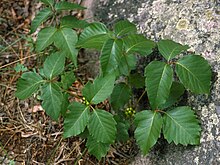Toxicodendron rydbergii
| Toxicodendron rydbergii | |
|---|---|

| |
| Scientific classification | |
| Kingdom: | Plantae |
| Clade: | Tracheophytes |
| Clade: | Angiosperms |
| Clade: | Eudicots |
| Clade: | Rosids |
| Order: | Sapindales |
| Family: | Anacardiaceae |
| Genus: | Toxicodendron |
| Species: | T. rydbergii
|
| Binomial name | |
| Toxicodendron rydbergii | |
| Synonyms[1] | |
| |
Toxicodendron rydbergii, the western poison ivy,[2] is a species of Toxicodendron in the cashew family. It is native to most of Canada from the Maritimes to British Columbia, and most of the contiguous United States except the southeastern states, New Jersey, Delaware, and California.[3] It can be found growing in forests, and other wooded areas, usually near streams and rivers.[4]
Unlike Toxicodendron radicans (eastern poison ivy), which often appears as a trailing or climbing vine, Toxicodendron rydbergii is a shrub that can grow to 1 m (3 ft) tall, rarely up to 3 m (10 ft). The leaves are trifoliate and alternate. The leaflets are variable in size and shape, and are usually 15 cm (6 in) long, turning yellow or orange in autumn. On the compound trifoliate leaves, the two leaflets opposite each other are typically asymmetrical, in contrast to the terminal leaflet which always shows bilateral symmetry. The fruits are small, round, and yellowish.[4][5]

Description[]
Toxicodendron rydbergii is a bushy shrub (height 30 cm). Leaves alternate, often shiny; with 3 divisions (leaflets), each with a tail, the one in the center a little longer; leaflets irregular in outline and sinuous with or without teeth, well marked veins; color varying with the seasons: wine red in spring, green in summer and multicolored in autumn. Creamy white or greenish flowers clustered in cones at the base of the leaves. Ribbed fruits; white, yellow or brown; the size of a dry pea; noticeable especially when the leaves have fallen. Most often, we find individuals without flowers and fruits.
Caution[]
All parts of this plant contain urushiol, which can cause severe contact dermatitis in most individuals.
References[]
- ^ "Toxicodendron rydbergii". Tropicos. Missouri Botanical Garden.
- ^ USDA, NRCS (n.d.). "Toxicodendron rydbergii". The PLANTS Database (plants.usda.gov). Greensboro, North Carolina: National Plant Data Team. Retrieved 11 December 2015.
- ^ "Toxicodendron rydbergii". County-level distribution map from the North American Plant Atlas (NAPA). Biota of North America Program (BONAP). 2014.
- ^ a b Innes, Robin J. (2012). "Toxicodendron radicans, T. rydbergii". Fire Effects Information System (FEIS). US Department of Agriculture (USDA), Forest Service (USFS), Rocky Mountain Research Station, Fire Sciences Laboratory.
- ^ Rydberg, Per Axel 1900. Memoirs of The New York Botanical Garden 1: 268–269 Archived 2018-08-07 at the Wayback Machine as Rhus rydbergii
- Toxicodendron
- Flora of North America
- Plants described in 1900